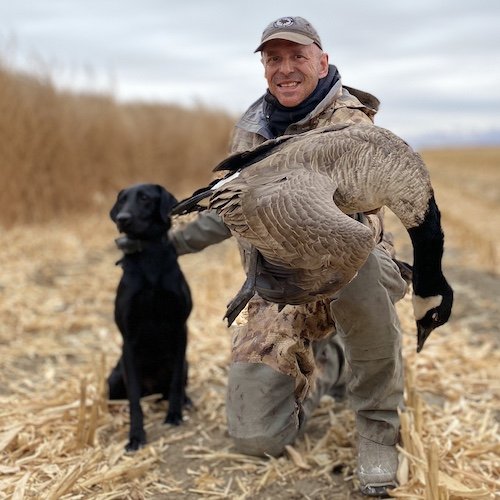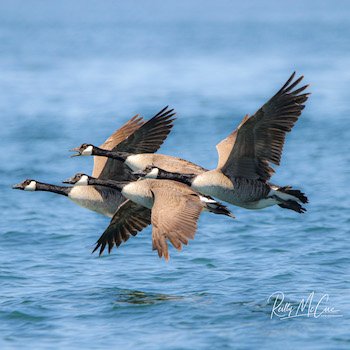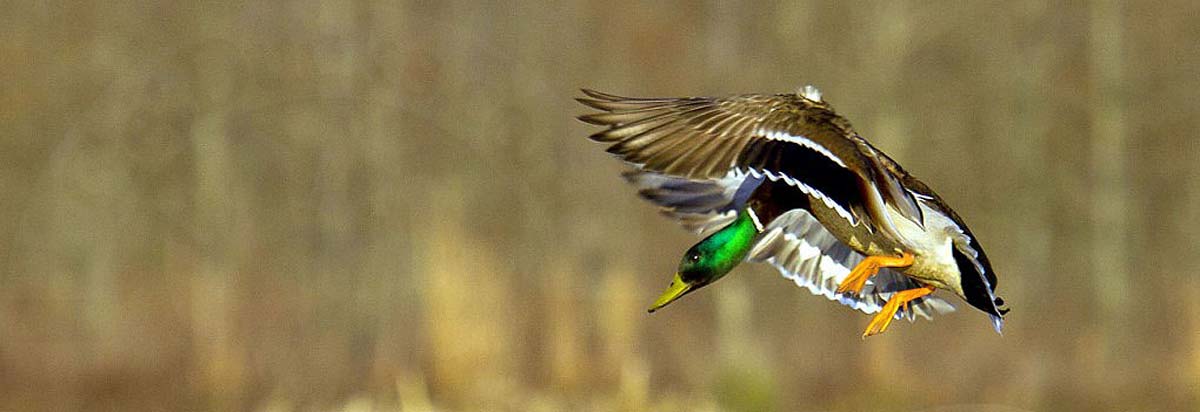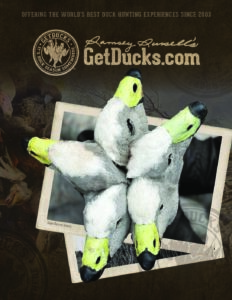Canada Goose

Canada Goose (Branta canadensis) is one of the most iconic and recognized North American waterfowl species. There are 7 Canada goose subspecies, including the Atlantic, Interior, Giant, Lesser, Western, Dusky, and Vancouver Canada Goose, and differences are not easily distinguished because many geographical areas are integrade zones for one or more races. Until 2004, the 11 subspecies comprising Canada Geese and Cackling Geese were all classified as “Canada Goose subspecies.” Now, because of genetic differences, Canadas and their smaller forms, cacklers, are classified as stand-alone species. Typical Canada Geese characteristics include a black bill, legs/feet, head, neck, and tail feathers; a white patch on the cheek and breast; and an overall brown-gray body. In flight, a white horseshoe may be seen on the rump surrounded by black plumage. Sexes display similar plumage, and males are only slightly larger than the females. It has been observed that there is an east-west coloration cline: lighter subspecies are found in the East and darker subspecies are usually found in the West.
Available Hunts
-
Sweden Goose Hunting
Sweden goose hunting unequivocally represents the highest-volume decoys goose hunts on earth, especially mid-November through December.
...read more- High-volume goose hunting packages
- Flat-package rate for maximum 6 hunting guests (exclusive groups only).
- Customized lodging packages (with/out lodging, upgrades)
- Greylag, barnacle and Canada geese depending on your seasonal preferences.
- 3 mornings goose hunting. Optional driven pheasants may be reserved.
- Expectations of 20 geese per man-day are reasonable. No limits, the potential bag can be greater.
Rate: see details -
Texas Goose Hunting – Panhandle
Texas goose hunting the west Texas panhandle remains America's best kept secret. Countless, shallow playa lakes in a landscape of agriculture provides perfect overwintering habitat for thousands of geese, ducks and sandhill cranes.
...read more- High-success hunting (goose or crane limits are the norm)
- Canada geese, white-fronts, snows, ducks, sandhill cranes, and more
- Many exclusive hunting properties within 1-hour radius of Plainview
- Combos and afternoon hunts available
- Camp-house lodging available (not a hotel hunt)
Rate: $375 -
Texas Waterfowl Hunt – Desert Paradise
Texas waterfowl hunt packages features relatively unpressured ducks, geese and sandhill cranes in an area so large it takes 3 lodges to cover and so ecologically diverse that most Central Flyway waterfowl species can be hunted!
...read more- Inclusive Texas waterfowl hunting packages for ducks, geese, sandhill cranes, doves, early blue-winged teal, spring turkeys, more.
- 3 lodges to cover vast, relatively undisturbed waterfowl hunting area and to offer flexibility for desired bucket-list species, amenity-level needs, or personal budget
- Central flyway puddle ducks to include prized mottled duck, Mexican duck, cinnamon teal, fulvous whistling duck, black-bellied whistling duck opportunities all right here in USA
- Sandhill crane hunting and white-fronted goose hunting are the Speck Ops Waterfowl house specialties
- Luxurious lodging with over-the-top and fun activities provide fun for bachelor or business hunting groups, entire families and non-hunters,
Rate: $2,000 to $2,900 -
Wyoming Duck Hunt
Wyoming duck hunt at Mountain View Mallards entails plentiful mallards and Canada geese in one of the most stunningly beautiful parts of America. Hunt comfortably from heated blinds and enjoy the show.
...read more- Predominately mallards and Canada geese, other species seasonally
- Upscale, newly constructed 6-bedroom lodge, with excellent amenities
- 3 excellent chef-prepared meals daily, dinner feature beef
- December-January primetime
- Comfortable heated blinds, professional guide-staff
- For 2-6 hunters, maximum 12 guests
- Fly into Billings MT or Cody WY
Rate: $2,750 3-day package -
Wyoming Waterfowl Hunting
World-class hunting for mallards and Canada geese along the legendary North Platte River in Wyoming-Nebraska with long-time professional outfitter that has a proven track-record for success.
...read more- High-quality hunting experiences for mallards and BIG migrator Canada geese along legendary North Platte River
- Impressive 95% repeat-client bookings for past decade, completely sold out last 10 years
- Hunting eastern Wyoming and western Nebraska
- Professionally guided hunts, experienced guides, heated blinds, premier private properties
- Hotel accommodations and local meals available nearby
- Private air services within minutes, commercial air services in Denver (3 hours)
Rate: $2,100 (see details)
 Canada goose reintroductions have created resident goose populations that, along with migrators, can now be found thriving in suburban and urban areas. Breeding areas are found in all Canadian provinces and all continental United State, with highest densities in Canada. During the breeding season their diet consists of grasses and sedges. When migrating, they will fly in the “V” formation with the more experienced geese leading at the front of the flock. Canada Geese are skilled at removing corn kernels from old corn cobs. They frequent agricultural fields and prefer to forage on land. Their wintering grounds are similar to their breeding grounds as they are found from southern Canada down to northern Mexico. Subspecies generalized below:
Canada goose reintroductions have created resident goose populations that, along with migrators, can now be found thriving in suburban and urban areas. Breeding areas are found in all Canadian provinces and all continental United State, with highest densities in Canada. During the breeding season their diet consists of grasses and sedges. When migrating, they will fly in the “V” formation with the more experienced geese leading at the front of the flock. Canada Geese are skilled at removing corn kernels from old corn cobs. They frequent agricultural fields and prefer to forage on land. Their wintering grounds are similar to their breeding grounds as they are found from southern Canada down to northern Mexico. Subspecies generalized below:
Atlantic Canada Goose (B. c. canadensis) is the nominate race; most plentiful of the subspecies found on the east coast and prefer to breed near bog- or fen-like habitats. Bill length 48-65 mm. Breeds southeast Canada and northeast US, wintering primarily Atlantic Coast.
Interior Canada Goose (B. c. interior) may be easily confused with the Atlantic Canada Goose, but has more distinct barring on its grayish underbelly. Bill length 43-64 mm. Breeds east and south of Hudson Bay wintering historically southeastern US but now believed primarily to overwinter much further north.
Giant Canada Goose (B. c. maximus) is largest race, has the longest neck and is also one of the lightest in overall plumage color. This is the least vocal of all subspecies. Bill length 60-68 mm. Chiefly a resident of Great Plains region but has become proliferate through the US due to reintroduction programs.
Lesser Canada Goose (B. c. parvipes) displays the characteristic white cheek patches; however, they will often extend under the head. Bill length 36-49 mm. Breeds Arctic Canada west to eastern Alaska, wintering interior California and also Gulf Coast and into Mexico.
Western Canada Goose (B. c. moffitti) shares the same light plumage. An alternate name for this species is the Great Basin Canada Goose. Bill length 36-49 mm. Breeds Great Basin region, wintering western US.
Vancouver Canada Goose (B. c. fulva) uniformly dark rufous. Bill length 45-60 mm. Resident British Columbia to southern Alaska, wintering as far south as Northern California.
Dusky Canada Goose (B. c. occidentalis) is darker and smaller than Vancouver. Bill length 41-48 mm. Breeds coastal southern Alaska, watering Vancouver and Oregon; and is protected throughout most of its wintering range due to nesting ground-related population reductions.
For reasons previously noted, differentiating Canada goose subspecies should be predicated on more than general descriptions. Ducks, Geese and Swans of North America (Belrose 1980) depicts breeding grounds, migrational corridors and wintering areas, and also provides additional biometric data such as tarsus lengths. This information is helpful in tackling Canada Goose subspecies identification.







